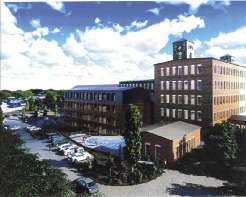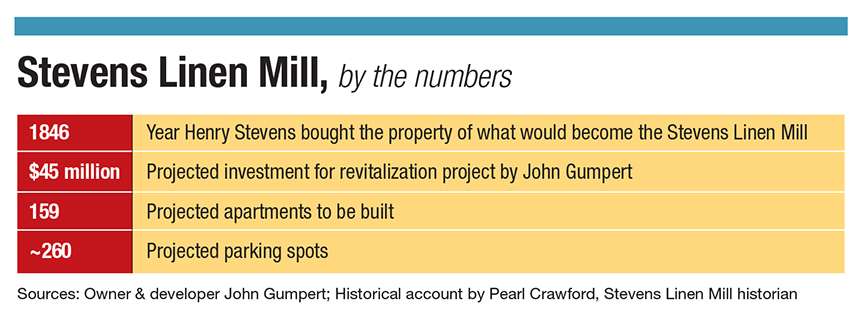
Dudley $45M mill redevelopment seeks to further anchor a revitalization
 Photo | Monica Benevides
Developer John Gumpert is seeking to preserve the Stevens Linen Mill while updating it to a mixed-use development.
Photo | Monica Benevides
Developer John Gumpert is seeking to preserve the Stevens Linen Mill while updating it to a mixed-use development.
What would eventually become the Stevens Linen Mill in Dudley dates back to 1811, with the founding of the then Merino Wool Factory Co. Over 200 years and several ownership changes later, the vacant 1864-era complex remaining today is on the brink of being redeveloped into loft apartments, which stand to breathe new life into an otherwise quiet old mill community in Central Massachusetts.
Plans for the site, now owned by Georgia developer John Gumpert of Camden Management Partners, call for the tune of 159 apartments, 260 parking spaces, and a series of amenities, including a pool, gym, and public access to the French River, on the banks of which the building sits, towering over the Webster-Dudley town line. Space will be left in the building for a community event center, and, potentially, a taproom, although no tenant is in place.
“We act as a catalyst to start redevelopment in the area,” Gumpert, who plans to invest upward of $45 million into the project, said.
Gumpert’s team has more than two decades of experience rehabilitating historic sites, particularly old mills, up and down the East Coast, he said, including developments in New England. Locally, he’s working to redevelop the behemoth River Mill in neighboring Thompson, Conn., although that project is in the process of tackling environmental challenges.
He has another project going on in Vernon, Conn., as well as mill projects in North Carolina.
“I’m an historic redeveloper, and I like saving,” he said.
His attention was drawn to Dudley when a broker approached him and told him about the Stevens mill. Several groups had tried to save it over the course of the last couple of decades, but no one had, at that point, ever followed through.
“I’m not sure how he got my name, but he did,” Gumpert said.
Community support
For all intents and purposes, Gumpert and his team appear to have the town behind them in their efforts to see this project come to life. As it stands, the proposal is in the local permitting process, but the approvals are moving along, said Acting Town Planner William Scanlan.
“There’s a number of loose ends that they’re working on,” Scanlan said, mentioning traffic mitigation issues.
Although Dudley is a generally quiet town, the area around the Stevens complex, known as Merino Village, is relatively densely populated. With nearly 160 new units going in, that congestion stands to increase.
Still, Scanlan said, public support appears to be broadly behind the project, especially considering residents approved a generous 20-year tax break at a special town meeting on Oct. 25. Under the tax increment financing agreement, Gumpert will be exempt from paying property taxes applicable to the value of improvements made to the mill for seven years. After that, ownership will be responsible for paying taxes on the property’s improved value at various increments, beginning at 10%, for the lifespan of the agreement. By year 20, the exemption will be 25%.
Although it’s hard to say what either Dudley, or the economy, will look like in two decades, Gumpert said he’s not typically one to fix and flip properties. He plans to remain owner of the mill once work is done, while hiring an outside property management company.

A 211-year history
The project complements another mill revitalization project in town, on Chase Avenue, where DMA Holdings is in the process of building out a 175,000-square-foot building which will operate as a cannabis growing, manufacturing, and retail space, the latter of which Scanlan said is close to opening. At the same time, the Stevens redevelopment stands in contrast to what happened in Hopedale, where the historic Draper mill complex was demolished last year despite its historical significance to the town and the American Industrial Revolution.
Redeveloping the Stevens mill would avoid that outcome happening in Dudley, where the mill was designated as part of the Stevens Linen Works Historic District by the National Register of Historic Places in 2010.
Like Draper, which was the largest manufacturer of automatic cotton looms in the world at the turn of the 20th century, the Dudley mill is another significant piece in the mill history in South Worcester County. The building Gumpert aims to bring back to life was built by Henry Hale Stevens, part of an industry powerhouse family hailing from North Andover, who bought the property and moved to Dudley in 1846, sourcing granite for the structure from his own property, according to a history written by Pearle Crawford and maintained by the town’s library.
The investment found success. As it grew, the Stevens mill in Dudley was at one point producing in the realm of 15 million yards of linen toweling per year, per Crawford’s history.
The company, Stevens Linen Works, was led by members of the family before being sold to textile giant J.P. Stevens Co. of New York, another family firm, in 1907. By 1939, the Dudley operation was set to be liquidated when members of the Crawford family, who had worked at the company for generations, formed Stevens Linens Association, Inc., and purchased the business for themselves. The business continued running for decades, eventually changing hands toward the end of the century. According to the Massachusetts State Register of Historic Places 2010 report, linen fabrics were manufactured in the mill under the Stevens name until 1993, with other textile manufacturing continuing until 2003. It’s been mostly vacant ever since.
“As a whole it’d be a neighborhood revitalization,” said Scanlan, of his project.

Young professionals and retirees
He and Gumpert expressed interest in courting two sets of residents: young professionals and area retirees looking for a less stressful living option as they age out of maintaining their homes.
As such, design plans include only one- and two-bedroom apartments, with the majority falling in the former category. About 10% of all the units will be designated as affordable.
A subset of Dudley resident have expressed concern about the strain such a development might put on the school system. Scanlan said fears around that issue are not likely to come to fruition, with the Dudley-Charlton Regional School District actually reporting decreased enrollment as of late.
“The fear of increased school costs doesn’t seem to be very significant here,” he said.
For now, it’s a matter of finishing up the approval process and getting construction off the ground. Once that happens, Gumpert said, he’s projecting about an 18-month build. If all goes well, work will begin this year.
“It’ll be fun to watch all of it,” Gumpert said.









0 Comments